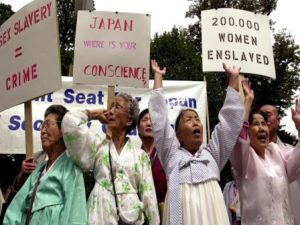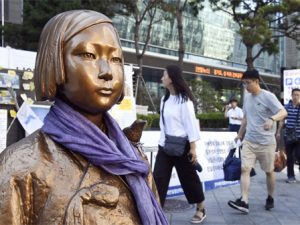Japan’s Comfort Women
Sexual slaves for Japan’s army are a less-debated concern and demands the attention of the human rights activists, especially from women leaders across the world.

Known as Comfort Women, their lives were plagued by pain, shame and injustice which followed them even after the end of the Second World War. Most of the comfort women are dead and many are losing the evidence to the diminishing memory with age. Having lived under anonymity for a long time, they finally opened up. Most of the comfort women belonged to the Asian countries like Korea, Taiwan and China.
Coerced or kidnapped into the Comfort Stations across the globe wherever Japan’s imperial Army fought against enemies, the Comfort Women were simply made to perform acts meant for sex slaves. Many of the women were lured into these stations by coercing them into thinking that they were to get a job as a nurse or helping hand but then shoved into the Comfort Stations. One of the first Comfort stations was probably established around 1932 after the Nanjing Massacre when the Japanese Emperor was forced to hide his Army’s brutal face and find a way to provide them pleasure at the same time.
Also Read : Sexual Abuse In India Four Child Survivors Every Hour And A Pending Legislation
Let’s Talk In Numbers
There is no clear estimate of the number of women recruited as Comfort Women. However, the estimates vary from 80,000 to 100,000. The Japanese army is said to have devised a formula to find an estimate of the number of women required for sex slavery. According to the formula, there was a requirement of 20,000 women per 7,00,000 Japanese soldiers, that is, one Comfort woman for 35 soldiers. Around 3.5 million Japanese soldiers were posted in Japan’s South Asian colonies, and thus, it is estimated that 1,00,000 women were recruited as sex slaves.
Many in the Japanese Army were set to the task of procuring women to maintain an endless supply of women. The Comfort Stations were usually set up near the military bases or directly with the barracks of the Army in cases of remote areas. Many of the recruited Comfort Women were young and unmarried because they had fewer chances of having sexually transmitted diseases which could spread amongst soldiers. They were also regularly checked for the diseases and the soldiers were provided condoms. However, this did not stop the diseases to spread as, according to the official medical reports, 15 to 20 per cent of Comfort Women suffered from venereal diseases.
The Ordeal of Comfort Women
The women were regularly beaten, threatened and attacked. Also, there were incidents of forced abortions reported amongst the Comfort Women.
Many of the Comfort Women committed suicide by hanging, poisoning and drowning themselves as they were unable to bear the shame and mental pain of being a sex slave along with the physical pain of STDs.

There was confusion after the end of the Second World War. The Comfort women had no livelihood and they were residing in foreign countries (Japan’s colonies and where it fought the war). They had lost connection with their families, had no money and way to contact them. The fear of being an outcast among their people, many of the women decided to stay back in the countries where they were brought and spend the rest of their lives.
Japan never paid for anything done by its army and ran away from its history and mistakes as there was no official financial compensation programme. In 2007, the Japanese Supreme Court decided that they have no claim to damages.
Japan’s Attitude
The Kono Statement 1993, presented by Yohei Kono (Chief Secretary of Cabinet), was issued to acknowledge Japan’s responsibility for the misfortune of Comfort Women supplied from Korea. It also issued an official apology to the women and decided to include this part of history in the textbooks of Japan’s curriculum to teach the young Japanese population about their dark history. The result was that the Secondary textbooks covered the topic of Comfort Women by 1997.
However, Shinzo Abe, the Prime Minister of Japan, decided to eliminate the chapters in 2007 using a Patriotic Education Bill which required the publishers to publish the topic as per the Government’s views. He claimed that the lack of evidence was the reason behind it. In 2010, The Japanese Prime Minister Naoto Kan issued an official apology to the Comfort women which was nullified by Shinzo Abe. In 2015, Shinzo Abe and Korean President Park Geun-Hye signed an agreement where he agreed to donate 1 billion yen to support the living of former Comfort Women in Korea. However, many of the victims refused to take the money as it wasn’t accompanied by an apology and properly justified.
In 2017, Japan recalled the Korean ambassador for putting a statue of a girl representing Comfort Women outside the Japanese consulate in Busan.
Also Read : Ashoka University Sexual Harassment Case Closed Irregularities In Due Process
In 2018, Shinzo Abe rejected the calls made by South Korean leadership to issue an apology for the sexual slaves of Japanese army saying that the attempt to revisit the 2015 agreement is unacceptable as it has already been implemented. The agreement was even accepted and appreciated at the international level.
The Women
In a brave attempt to bring the fellow victims to justice, Kim Hak Sun (former comfort woman) first brought the subject into light in a press conference in 1991. From then on, many of the victims have come up with their experiences of them living in comfort stations. The women had demanded an apology, genuine discussion on their plight and compensation from time to time. As of 1016, 239 women were registered with the South Korean government as victims of sex slavery by the Japanese army.
The sexual slavery of Asian women by the Japanese army is yet to be recognized as a war crime as they are not considered as direct victims of the war. Thus, the conversation hasn’t received international society’s consciousness. Sadly, many of the women are already dead and their testimonies now survive through videos, texts and audios recorded by the media community and those who empathized with them. Their stories are getting lost with time, memories and their deaths, yet justice eludes them with every passing moment.
